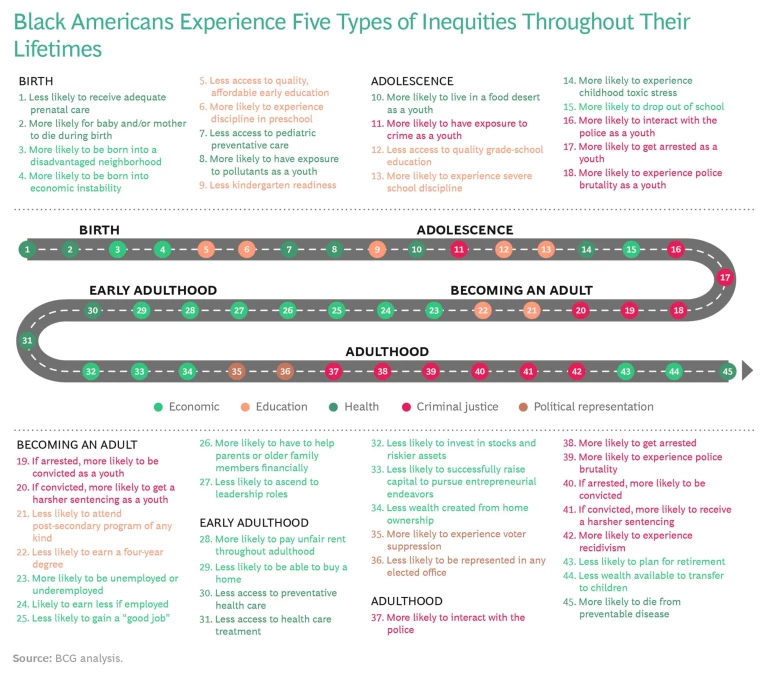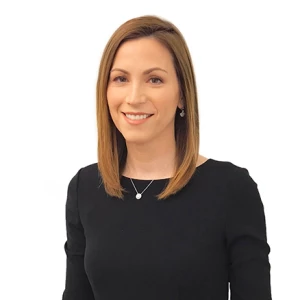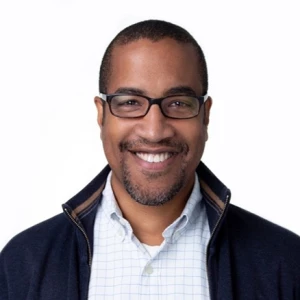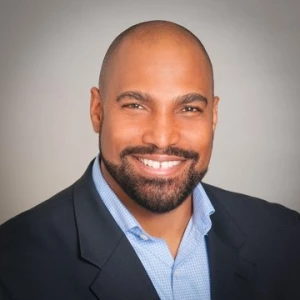The death of George Floyd in Minneapolis last May resurfaced long-simmering outrage over the protracted history of police brutality against Black Americans in the US. The public protests that ensued reverberated nationwide, placing the realities of racial injustice and disparity front and center. Today, in the midst of a pandemic and a polarized political landscape, leaders in US government, civil society, business, and academe are struggling with how to respond. They ask: What actions can we take to address the inequities and long-standing injustice in our society? How do we help rectify the economic and social systems that reinforce, if not validate, inequality?
Business leaders tell us they want to support their employees and help them process their emotions. They tell us that, as members of society, they want to take action. But in what ways? How can we channel outrage into action to promote meaningful change?
We believe that revisiting their corporate purpose offers companies the best guide. Purpose can illuminate a path, authentic and actionable, that an organization can take to do its part in advancing racial equity . With purpose as both springboard and North Star, leaders will develop strategic action plans that include listening and acknowledgement, making bold commitments (now and in the medium term), and channeling their organizations’ unique role to advocate for long-term change.
A Corporate Purpose Moment
Business leaders increasingly recognize that, beyond delivering value to customers and shareholders, they have a commitment to all stakeholders, as articulated in corporate policies, investment strategies, and organizational purpose. As the Business Roundtable declared in 2019 (in a statement signed by some 180 CEOs of major US corporations), investing in employees, engaging ethically with suppliers, and supporting the communities in which we work benefits not just our companies, but also is essential for the future success of our communities and our country. Just as leaders recognize that climate change isn’t an issue only for manufacturing industries or governments, so, too, they understand that racial equity and social justice are not just public- or social-sector issues. They are everyone’s issues.
To respond constructively and to work toward a more equitable society, companies need to lean into their purpose. As the intersection of an organization’s unique strengths and its enduring aspiration to fill a need in the world, purpose is the most powerful tool businesses can leverage to effect change.
To respond constructively and to work toward a more equitable society, companies need to lean into their purpose.
Your organization’s unique strengths will allow it to foster greater understanding and take meaningful action. Purpose will guide you in examining the role that current behaviors and inclusion practices at your organization may inadvertently play in exacerbating barriers to racial equality—and help you confront any uncomfortable behavioral truths and address them effectively. Understanding the unique societal role that your company plays can help you shape authentic messaging and communications, and develop corresponding actions that align with your strategic goals. It can also suggest potential partnerships with external organizations and programs that align with your organization’s values, so that together you can channel your competencies to create lasting change.
Companies today that are taking a strategic, purpose-driven approach to appropriate action begin with three broad steps.
1. Listen first, then issue timely statements of values and beliefs. In the immediate aftermath of tragedy, whether it is experienced collectively or individually, people experience shock and grief. At that point, active listening is the most important initial response. The current context reveals what has been in plain sight to many; employees, colleagues, associates, and friends of color who have traditionally been underrepresented will be especially vulnerable. By listening and committing to learning, meaningful dialogue can take place. Every organization can better support employees, as well as infer what actions to avoid that might spare those who are already hurting from unintentional, further wrong. You can foster dialogue through a number of methods, such as small group conversations, one-on-one listening tours, formally facilitated diversity, equity, and inclusion (DEI) discussions, or dedicated Slack or other technological channels.
By listening and committing to learning, meaningful dialogue can take place.
Once you’ve authentically listened, then you are ready to demonstrate empathy and support by issuing a timely statement of beliefs. This statement should reinforce your values, bolster the organization’s commitment to DEI, and engage the organization through empathy and ongoing dialogue.
A blog post from Marvin Ellison, the CEO of Lowe’s, shows how one leader expressed empathy rooted in personal and organizational values. His post reflects the Lowe’s ethos of helping customers create a place of safety and comfort, while acknowledging the higher cause of social justice as part of the company’s responsibility as a corporate citizen. Ellison spoke authentically from the heart to recount a personal experience:
I grew up in the segregated South and remember stories my parents shared about living in the Jim Crow South. During this time of Jim Crow, people of color were viewed and considered second class citizens. So, I have a personal understanding of the fear and frustration that many of you are feeling. To overcome the challenges that we all face, we must use our voices and demand that ignorance and racism must come to an end. This is a time to come together, to support one another and, through partnership, begin to heal.
Ellison’s statement is both personal and empathetic in addressing what his employees, their families, and their communities are experiencing. He then relates it to the company’s values and ways the company is currently engaged in living those values:
At Lowe’s, we are committed to helping people make their homes better, and today, we recognize that our homes extend beyond our walls, and into our neighborhoods, communities, and country. We take this corporate responsibility seriously, and as we’ve seen through the incredible workers on the frontlines of the coronavirus pandemic, we can meet and overcome tragedy, but only by coming together.
Listening and expressing beliefs is not a one-and-done affair. As events unfold—and as we witness continued tragedy and unrest—leaders need to reaffirm these beliefs, humbly and judiciously. Doing so demonstrates to stakeholders and the public that your values and concerns are prominent and sincere.
2. Commit to bold action. Even with a well-orchestrated and holistic change program under way, substantive outcomes might take time to become visible. To sustain support through this ambiguous interim, tap into your organization’s purpose to inform bold commitments that demonstrate intent and guide concrete action.
Bold commitments and purpose go hand in hand. For example, to activate Mercedes-Benz’s stated purpose—“First Move the World”—the automaker pledged to make its German plants carbon neutral by 2022. This pledge constituted both a direct action stemming from the company’s vow to make change first, as well as a public commitment to that change. Likewise, the Bank of Montreal pledged to double its commitment to sustainable finance to CAD 400 billion to abide by its purpose, “To Boldly Grow the Good in Business and Life.” BMO restructured its corporate governance to institute leadership for the fund that would ensure the bank helped clients achieve their sustainability objectives.
What might your own company’s bold commitments be when it comes to diversity, equality, and inclusion? This is not about simply setting benchmarks, since DEI is not about hitting quotas. Rather, it’s about acting in a way that is demonstrably and palpably inclusive and supportive to stakeholders.
Challenge your organization to show how it will reduce and eliminate barriers to inequality, and to redefine what success looks like through a different lens.
Such corporate commitments should be specific, measurable, and public. Challenge your organization to show how it will reduce and eliminate barriers to inequality, and to redefine what success looks like through a different lens. As a starting point, take stock of your recruiting and hiring; team composition; retention and advancement parity, reward and recognition structures; training programs and conversations on DEI; purchasing and community investment practices; thought leadership and publications, and external commitments to local, regional, national, and international communities. (For a look at how one city is translating outrage into action, see “Atlanta’s Leaders Step Up to Combat Police Brutality.”)
Atlanta’s Leaders Step Up to Combat Police Brutality
While municipal leaders elsewhere responded to public outrage by conceding to demands to reexamine policing policies, Atlanta’s leaders recognized that an unconsidered move could risk public safety and police morale. Timely action mattered, of course, but just as important would be a thoughtful, data-based, multiperspective analysis that could pinpoint causes and help target constructive action, both near- and longer term.
In approaching this important work, the Atlanta advisory council understood that it had to conduct more than a statistical deep dive. The analysis had to spring from a humane and purposeful place: the need to address policy change as a step toward healing the city, and to bring together stakeholders from across the community spectrum, who had tremendous investment in the outcome, to participate in the process. An honest and constructive examination would have to take into account not only residents’ experiences and perceptions and the harm that victims have suffered, but also the perspectives of police, who are asked to put themselves in harm’s way daily to maintain public safety.
After initial discussions and data review, the task force reached out to local thought leaders. It was important to examine police use of force in a historical context; to look at the incentives, both at the local and federal levels, that underpin police practices and that have led to the militarization of police departments nationwide; to examine practices in other cities to see the range of response strategies, including Camden, New Jersey’s innovative and successful community policing reform. Some solutions already existed in Atlanta—for example, a pre-arrest diversion program that allows for alternative outcomes for minor drug offenses. There, the question was: Why were those alternatives underutilized, and how could the city transform them into more comprehensive solutions? Council members understood that to succeed, the outcome of this effort would have to be more than a political win; it also would have to plant the seeds of reconciliation.
Both the process and the product of this effort show the role of purpose as a catalyst and guidepost. The stories and history we unearthed along with our research were assembled into a digestible primer, titled “The Way Forward,” designed to engage the public and stimulate action. The primer has also been used to help seed a social media campaign to build awareness.
Recently, as part of its purpose, BMO Financial Group CEO Darryl White announced a variety of initiatives to combat racial inequities. “Creating a more inclusive society is foundational to who we are as a company,” he said, “and that includes removing impediments to career progression that disproportionately impact Black, indigenous, and people of color (BIPOC) employees across the financial services industry.” The bank embarked on setting new five-year goals to address gaps in workforce representation among diverse groups and to measure progress in promoting the career advancement of diverse employees. BMO created a Black and Latino Advisory Council, whose senior leaders will focus on employee experience, advancement, and the engagement of Black and Latino talent through task forces. In addition, BMO looks to the work of Canada’s Indigenous Advisory Council (created in January 2020) to inform its policies and practices, raise cultural awareness through training, create jobs and training for indigenous peoples, and seek long-term sustainable economic growth for indigenous communities. Among its other actions, the company has established educational resources for employees (including resources on racial injustice and BIPOC experience); it has bolstered access to development programs to build the leadership pipeline and skills for BIPOC talent; and it is ensuring that 40% of student opportunities (such as internships) are directed to BIPOC youth.
3. Use your organization’s unique role in the world to advocate for long-term structural change. Because reducing systemic racism means attacking the disease rather than its symptoms, organizations will need to take continuous action, create strategic and creative partnerships, and demonstrate unwavering dedication—all of which takes tremendous energy. That’s why leaning into purpose—which provides both the rallying cry and the motivation to engage employees’ discretionary effort, while illuminating a clear and mutual path—is so suited to effecting substantive long-term change.
How do companies find their purpose? They start by exploring and then articulating the role in the world the organization is meant to play.
How do companies find their purpose? They start by exploring and then articulating the role in the world the organization is meant to play. Understanding how your company can tap into its strengths and uniquely address aspects of larger systemic issues is important for achieving the greatest impact. A knee-jerk reaction to injustice is to take action immediately, to right what is wrong in a heartful but reactive way. Yet recreating efforts that others already do well runs the risk of duplication and can result in well-intentioned but subpar solutions. To change the system holistically and for the long term, rather than being reactive, companies should strive to be considered and thoughtful about where they can add the most value, honest about what they do well, and open to recognizing and embracing complementary partnerships.
For example, financial institutions can reverse inequities directly through their products, through access to capital, and by developing offerings that help build wealth and encourage savings. They also have the influence to address racism through ongoing recruitment, hiring, and development practices, and DEI efforts, as well as through their investments and shareholder influence. In this way, financial institutions can offer what they do well as a lever in a larger-term approach or solution. (See “By Applying Its Strengths, BCG Illuminated Its Path of Action.”)
By Applying Its Strengths, BCG Illuminated Its Path of Action
As a management consultancy, BCG’s sweet spot of expertise is the use of empirical evidence and rigorous data-based analysis (both qualitative and quantitative) to help understand challenges and problems and point to solutions. As a first step to identifying how to work toward long-term structural change, we conducted root cause analysis to examine the challenges Black Americans face. Analyzing life-stage data from birth through old age, we pinpointed key sources of disparities at their origin. These findings would help us understand the drivers of systemic racial inequity and identify opportunities for BCG to combat it through partnerships, philanthropy, community work (research, program sponsorship, and volunteer efforts), and other actions.
We looked at key outcomes in five spheres—economic, education, health, criminal justice, and political representation—quantifying and depicting them in a life-stage pathway. (See the exhibit.) For example, even before birth, Black Americans face health and wealth disparities that manifest in lower rates of first trimester prenatal care, greater infant mortality rates, and childbirth-related mortality rates for mothers. Black children are more likely to live in poorer or single-parent households and to experience inequality in health and education, from pre-kindergarten suspensions and lower average school funding rates to exposure to food insecurity, threatening experiences, and pollutants in their environments. We looked at the disparities Black young adults experience as they enter the workforce, analyzing such data points as four-year college completion rates, the odds of landing a good job, earning at-par wages, and unemployment relative to other racial groups. Then we compared outcomes for early career adults, as measured by rates of home ownership, quality of medical care received, voting patterns, and political representation. Finally, we examined the outcomes from a lifetime of inequities (which are often passed on for generations), such as career ceilings, retirement assets, and vulnerability to complications and death from long-term health problems.
This analysis confirmed that inequities have a foundation in systems as well as the behavior of individuals in power, and creating lasting social change will involve tackling four key drivers: government policy, institutional policy, the behavior of institutional actors (who uphold policies and norms), and the behavior of community members. By identifying these drivers (as depicted in the life-path exhibit), we have clarified areas of opportunity for BCG to channel outrage into action, including identifying partnerships we can forge that will amplify the impact of our mutual efforts.
As you explore partnerships, be realistic about your organization’s core competencies, and how the value you offer can translate into broader issues that define the DEI space. For example:
- Is your company an expert in communications? Partner with an organization that works to register new voters and create compelling and insightful campaigns to change the long-term landscape of representation.
- Are you an expert in finance or investment? Seek out organizations that create opportunities for minority businesses and add your dollars, expertise, or both to expand opportunities for minority-owned business and executives.
- Does your organization have charitable foundations? Consider linkages to local chambers of commerce, government, and NGO stakeholders who can be instrumental in driving change while also addressing structural and economic barriers to equity.
Empathy and Honesty Are Not Enough
Understanding unmet diversity, equality, and inclusion needs in the world today demands empathy and honesty—but also action. By creating ways that demonstrate support, by making bold commitments and seeing them through, and by creatively forging partnerships and coalitions, organizations can transform into a change-making force for good.
One of the greatest challenges in creating a more diverse, equitable, and inclusive world lies in infusing actions into the activities that individuals and organizations engage in—both the strategic as well as the day-to-day work. To overcome this challenge, companies must determine who they can be at their very best and then assess, with utmost honesty, how their people, processes, and behaviors measure up to this benchmark. For companies that desire to drive lasting change, consistently asking what specific actions they can take to further their purpose and align with partners is critical. Bringing unique value and equity to the large-scale problems we are trying to solve is a great means to beginning a purposeful journey with desirable and meaningful outcomes. If your organization is resolute in its commitment to greater diversity, equality, and inclusion in the US, then take a stand, take action, and proactively partner to align with our national purpose of providing liberty and justice to all.











